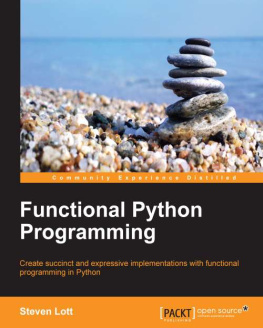Srikanth Machiraju - Beginning Functional JavaScript: Uncover the Concepts of Functional Programming with EcmaScript 8
Here you can read online Srikanth Machiraju - Beginning Functional JavaScript: Uncover the Concepts of Functional Programming with EcmaScript 8 full text of the book (entire story) in english for free. Download pdf and epub, get meaning, cover and reviews about this ebook. year: 2018, publisher: Apress, genre: Computer. Description of the work, (preface) as well as reviews are available. Best literature library LitArk.com created for fans of good reading and offers a wide selection of genres:
Romance novel
Science fiction
Adventure
Detective
Science
History
Home and family
Prose
Art
Politics
Computer
Non-fiction
Religion
Business
Children
Humor
Choose a favorite category and find really read worthwhile books. Enjoy immersion in the world of imagination, feel the emotions of the characters or learn something new for yourself, make an fascinating discovery.
- Book:Beginning Functional JavaScript: Uncover the Concepts of Functional Programming with EcmaScript 8
- Author:
- Publisher:Apress
- Genre:
- Year:2018
- Rating:5 / 5
- Favourites:Add to favourites
- Your mark:
Beginning Functional JavaScript: Uncover the Concepts of Functional Programming with EcmaScript 8: summary, description and annotation
We offer to read an annotation, description, summary or preface (depends on what the author of the book "Beginning Functional JavaScript: Uncover the Concepts of Functional Programming with EcmaScript 8" wrote himself). If you haven't found the necessary information about the book — write in the comments, we will try to find it.
Understand functional programming concepts and the functional nature of the JavaScript language. Starting with an introduction to functional programming concepts, you will learn the key differences between imperative and functional programming. Diving straight into JavaScript functions, you will learn to write them with ES8. Followed by this you will move to higher order functions and learn how Function as Data opens up a world of possibilities.
You will then build higher order functions with closures. Arrays will then be introduced, followed by a set of APIs you can use with them. You will learn how to transform one function to another using currying and partial application. The compose function will be discussed in detail, followed by functors and monads. After having an in-depth look at applicative functors, you will learn the new features offered in ES8.
The concluding chapters of Beginning Functional JavaScript will show you how to use a functional toolkit to build a small library that allows you to develop web applications, followed by tips on testing your functional code.
What You Will Learn
- Discover functional programming concepts such as string padding and async functions
- Identify how functions are treated in JavaScript
- Create a functional library that mimics Underscore.JS
- Deep dive into ES8 functional features such as spread operators and generators
- Create a library that works like the react-redux pattern by following the functional paradigm
Who This Book Is For
Novice JavaScript developers.
Srikanth Machiraju: author's other books
Who wrote Beginning Functional JavaScript: Uncover the Concepts of Functional Programming with EcmaScript 8? Find out the surname, the name of the author of the book and a list of all author's works by series.







![Anto Aravinth [Anto Aravinth] - Beginning Functional JavaScript: Functional Programming with JavaScript Using EcmaScript 6](/uploads/posts/book/120482/thumbs/anto-aravinth-anto-aravinth-beginning.jpg)




